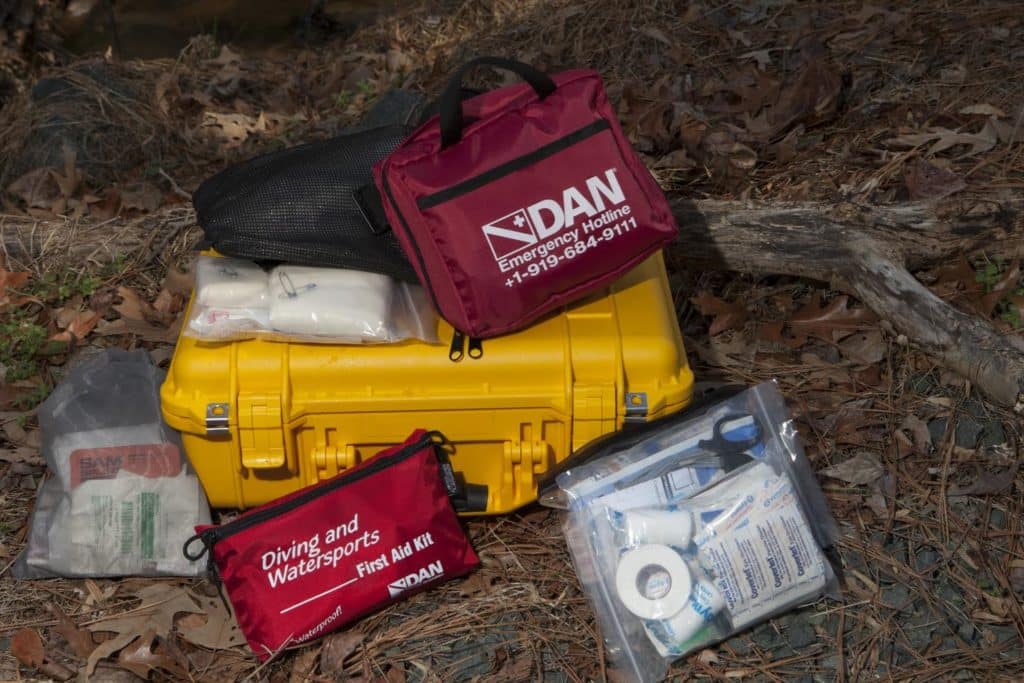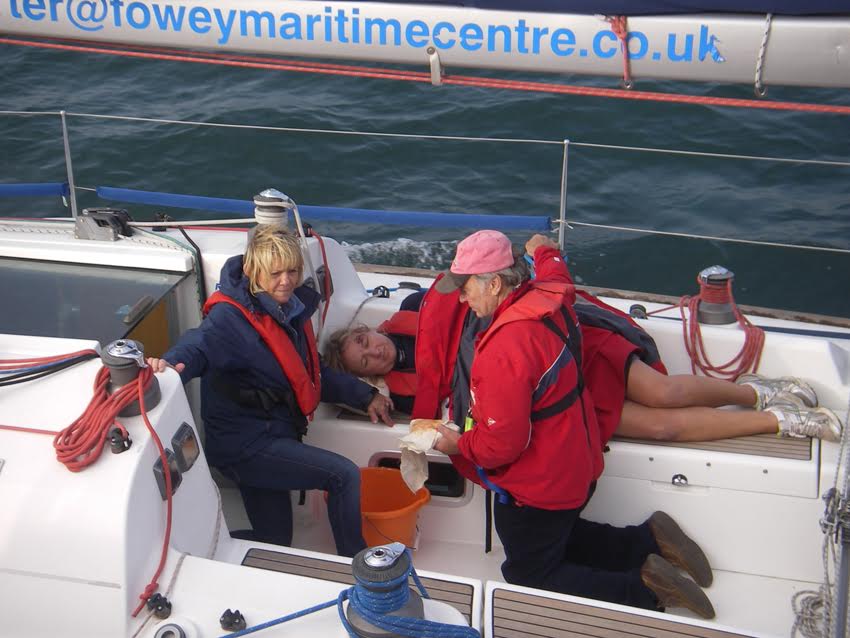
When I decided to sail across the Atlantic aboard Ranger, my 30-year-old Allied Seabreeze yawl, I spent a year refitting her. I slept with and dreamed about marine catalogs, and spent thousands of dollars on things to keep the boat moving and the crew aboard.
A month before departure, my first mate, a trusted, levelheaded sailor and nurse, called with bad news. He had just been diagnosed as HIV positive.
Suddenly, my nightmares of a man overboard or a hole in the hull became visions of bleeding cuts, gloves, barriers, sanitation, and dealing in close quarters with a sick man still juggling his new medical cocktail. It was the first time I’d thought about the health of my crew.
Ultimately, he elected not to go, as did my third crewman. The nurse packed a first-aid kit, and I threw it under the sink and took off with two strangers, prepared to handle anything the sea might hand us, I thought. But we weren’t prepared. And from everything I’ve gathered, neither are most sailors who set out on extended cruises.
A sailboat is a hazardous platform in a hostile environment. People on sailboats get cut, conked, bruised and burned, and can become nauseated, crushed, dehydrated, cold and sprained — and those are just the common problems. Sailors also bring with them an encyclopedia of pre-existing medical conditions, from obesity and age to heart disease and diabetes. All are compounded by the isolation of a vessel at sea.
“The majority of sailors are not prepared for medical emergencies,” says Dr. Miles Poor, a surgeon, offshore sailing veteran, and longtime fleet surgeon to the Caribbean 1500. Because Americans are used to a “911 mindset,” he says, we forget that even a mile offshore, we must be our own first responders. Yet most of us are untrained.
According to the U.S. Coast Guard, in 2015 in U.S. waters, 5,560 boats were involved in accidents with injuries or deaths. Only five — five! — of the skippers involved had American Red Cross first-aid training.
“People get drawn toward gadgets: Do I have the right sails? Do I have the right navigation tools? That’s great. But we need to think through the medical side of things, too. Is my first-aid kit appropriate? Do I know how to use it? Do I know what is in it?” says Dr. Jeffrey Wisch, a sailor, hematologist, and oncologist at the Dana-Farber Cancer Institute in Boston, and the fleet surgeon of the Cruising Club of America, which runs the Newport Bermuda Race.
One study of transatlantic sailors by a French physician found that half of them waited until the final month prior to departure to think about a first-aid kit. Fifteen percent didn’t deal with it until two weeks before setting sail, reports David Hayes, a University of Quebec chiropractic professor and sailor who teaches seminars for the World Cruising Club.
Hayes’ own survey of hundreds of sailors in the World Cruising Club’s rallies indicates that 65 percent wait until the last month to get any first-aid training. He remembers vividly, three days before departing the Canaries for the Caribbean, being approached on the docks by a mother. “Can you recommend a good first-aid book?” she asked. She was about to set off for at least 20 days at sea with her husband and children.

“If there’s an emergency, you won’t have time to pick up a book,” Hayes says. “There are steps you need to take, that you need to be trained for.”
Medical experts can ruin your daydreams with accounts of offshore emergencies: fingers cut off by fishing line, then cauterized in a frying pan in the middle of the Indian Ocean; a painful, untended dislocated shoulder during 15-foot waves from Hurricane Mitch; a mid-Atlantic lurch that knocked a sailor into a winch and left him brain-dead; a Gulf Stream chin laceration that required 12 sutures from Wisch — each stitch timed between waves.
Cruisers also explore exotic and primitive places. Daniel Nord, director of medical services for the Divers Alert Network, which reviews 5,000 calls for help a year, lists three pieces of advice: 1) Don’t rent a motor scooter, 2) don’t pet the monkey, and 3) don’t ride the elephant! He’s half-joking, of course, but there’s a lesson in there, too. Common sense can go a long way toward preventing mishaps.
Two people have died in 30 years of the Atlantic Rally for Cruisers, both after being struck in the head by a boom. But the most common injuries have been galley cooking burns, followed by rope burns (some down to the bone), cuts, punctures from fishhooks and knives, and many blunt traumas — bruises, bumps and broken bones — caused by falling around the boat, says Jeremy Wyatt, World Cruising’s director.
There are many easily learned first-aid techniques that cruising sailors can master: taking vital signs, treating burns, making splints and stopping bleeding. “First-aid training has prevented a bad situation from becoming worse,” says Wyatt. “Eight years ago, one sailor broke his arm and suffered a puncture wound. The crew had the perfect dressing and splint, and thought about where to put the sailor, in a bunk where he couldn’t move. That was a well-prepared crew.”
The vast majority of the 2,613 injuries and 626 deaths reported by the Coast Guard in 2015 were preventable. Drinking alcohol and not wearing a PFD were often contributing factors. “The first thing that goes onto a boat is a full cooler,” says Vann Burgess, the Coast Guard’s senior recreational-boating safety specialist. “People never expect to enter the water. Any sailor should be wearing a life jacket. It will keep you alive.”
Most problems can be prevented or treated with some training and common-sense forethought: simple stuff like hygiene, hydration, adequate sleep, seasickness pills, wearing shoes and gloves, and wearing a clipped-in PFD. First-aid kits should contain supplies that a crew can use. A suture or IV kit is useless without training. But you can use suture strips, and knowing just a little anatomy will help describe symptoms when you call for help.
As much as I pride myself on CPR and defibrillator training, I have learned that offshore, it might help in a drowning or shock but would not likely save a cardiac arrest, because of the need for follow-up meds. The $2,000 spent on an automatic external defibrillator “could be better spent on first-aid training,” says Wisch.
“Sailors think about doomsday scenarios on their boats,” says Hayes, “but appendicitis can happen to anyone, and that’s life-threatening. They need to be prepared for anything. The statistics say anything can and will happen.” Miles Poor tells his offshore classes: “In an hour, I’m not going to try to make you a doctor. But I want to make you realize that if you ask questions and can relay symptoms, you can go safely offshore, never have an issue, and have a good time.”
Transatlantic veteran Jim Carrier is a former award-winning journalist for The Denver Post and the author of The Ship and the Storm, a riveting account of the loss of the 282-foot schooner Fantome during Hurricane Mitch in 1998.








